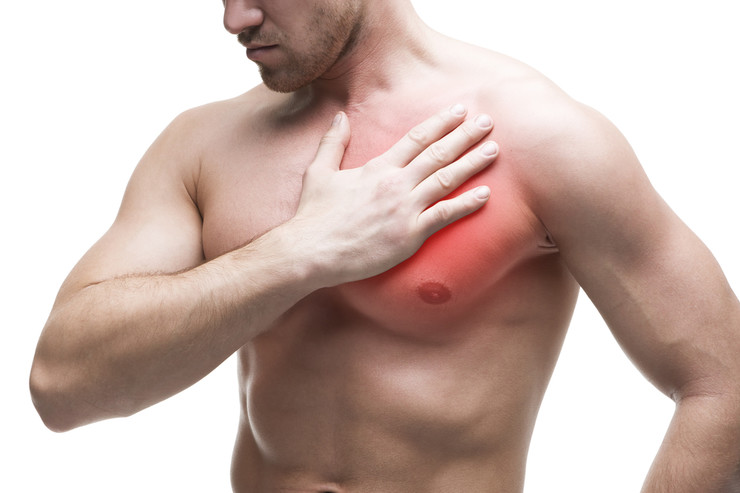The muscles of the chest are the pectoralis major and the pectoralis minor. In combination, these muscles play a highly important role in terms of shoulder and hand movements. People who have a chest muscle pulled are not in a life endangering situation; however, many believe that they are because the signs and symptoms mimic dangerous medical conditions like a heart attack which can lead to death. Many frightened people call 911 for help, and others may rush to the hospital emergency room. Although it can be painful and frightening, most of these injures are simply treated and the recovery period is relatively short, with the exception of the most serious injuries that involve the tearing of a chest muscle which will be discussed below.

Who Is at Risk for Pulled Chest Muscle?
These injuries can occur whenever there is a sudden jerk or excessive pressure and/or stretching of these muscles. Although this injury can happen to anyone, it is most commonly found among athletes who perform repeated or sudden movements of the chest muscles in an unusual and/or strenuous manner.
A baseball player diving for a fly ball in the outfield, a tennis player attempting to reach out and hit a ball distant from their body, and a hockey player who suddenly spreads their body over the ice to block a puck are three examples of athletes who are at risk for chest muscle injury.
Other people who are also at risk for pulled chest muscles include the elderly and young children. An elderly person can sustain this type of injury when they fall because they are confused, they lack balance and good coordination skills and/or they lack the good muscle strength that is needed to prevent falls. A young child can also experience this type of injury with a fall. By nature, young children are curious and they are not fully aware of dangers in their environment. Additionally, a parent, guardian or friend may pull the child's arm in an unnatural and forceful manner. These situations place the young child at risk.
Signs and Symptoms of Pulled Chest Muscle
The signs can be quite painful at times. Other than pain, some of the other commonly occurring symptoms that typically occur within 24 hours after the injury include tightness of the chest and an increasing burning pain that worsens with any movement of the affected area.
The injury is classified and categorized as Grade I, Grade II and Grade III. Grade I is the least severe. This grade typically affects only a few muscle fibers and nerves. The specific signs and symptoms associated with Grade I chest muscle pulls include mild:
- chest pain and discomfort
- limitation of shoulder and arm movement
- swelling (edema)
- loss of strength
Grade II injuries involve more muscle fibers than Grade I injuries and they can lead to a partial muscular tear and extensive tissue damage and pain. Bruising can be present when the injury was sustained with a blunt force trauma, as can occur with a contact sport like football or hockey. The signs and symptoms associated with Grade II injuries are:
- a muscle mass that can be felt or palpated because the area is swollen
- chest pain, particularly with arm and/or shoulder movement
- significant loss of movement and strength
- soreness over the site of the injury
Grade III, the most severe of all grades, are defined as a complete muscle tear and the loss of almost all muscular functioning. It can lead to serious and permanent damage when left untreated. Some of the signs and symptoms include:
- pronounced muscular and chest pain
- highly significant limitations of strength and movement
- bruising
- hematoma
Treatments and Recovery of Pulled Chest Muscle
The treatment of chest muscle pulls depends on the severity of the injury; however, generally speaking, the treatment involves the following interventions.
- Rest. You should avoid all physical activities that can make the condition worse and/or increase the level of pain. Rest will allow the muscles to heal.
- Pain Relief. Pain can be relieved with ice packs and mild analgesics such as acetaminophen (Tylenol). Ice packs relieve pain, decrease inflammation and reduce swelling.
- Surgical Repair. Surgery may be indicated with a Grade III injury to repair the torn muscle(s).
- Rehabilitation. Many people can benefit from the services of a physical therapist to restore function to the pre-injury state. As with all exercises, after injury, it is necessary to consult with your medical doctor. Stretching, light resistance and strength training exercises are highly beneficial to the recovery period; however, it is highly important to get your doctor's approval before engaging in these exercises and any physical therapy.
The recovery period for most people affected with a Grade I or II chest muscle pulls can recover in a couple of days. Those who sustained a Grade III chest muscle pulls may take weeks or months to recovery because of the severity of the injury and the surgical procedure that was done to repair the torn muscle(s).
